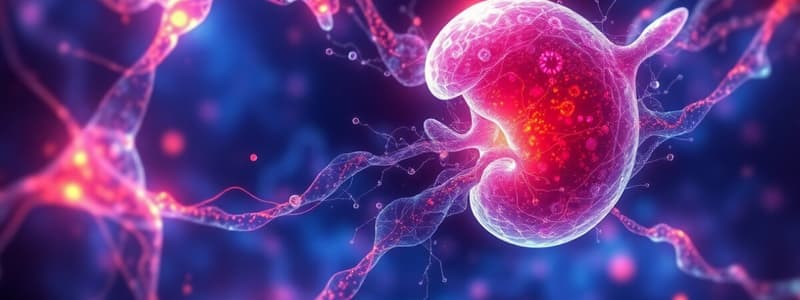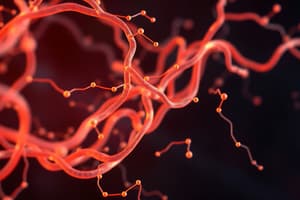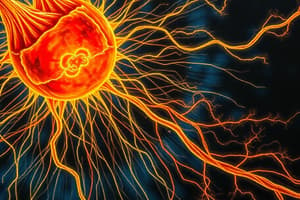Podcast
Questions and Answers
What can result from inappropriate or misregulated cell movement?
What can result from inappropriate or misregulated cell movement?
- Improved wound healing
- Tumor metastasis (correct)
- Enhanced immunity responses
- Increased cell adhesion
Which type of cell protrusion is typically flat and 2D, often found in fibroblasts?
Which type of cell protrusion is typically flat and 2D, often found in fibroblasts?
- Pseudopodia
- Cilia
- Filopodia
- Lamellipodia (correct)
What is the primary role of filopodia in migrating cells?
What is the primary role of filopodia in migrating cells?
- Exploring the environment for guidance signals (correct)
- Facilitating rapid division
- Formation of structural scaffolding
- Mass cell contraction
What is actin's role in the formation of cell protrusions?
What is actin's role in the formation of cell protrusions?
Which tool is used to visualize actin filaments in cells?
Which tool is used to visualize actin filaments in cells?
What role does cytochalasin D play in cellular processes?
What role does cytochalasin D play in cellular processes?
What occurs during the fluorescence recovery after photobleaching (FRAP) experiment?
What occurs during the fluorescence recovery after photobleaching (FRAP) experiment?
How do cells form attachments to the extracellular matrix?
How do cells form attachments to the extracellular matrix?
What mechanism allows the rear of a cell to retract during movement?
What mechanism allows the rear of a cell to retract during movement?
What property of myosin II contributes to the contraction of actin stress fibers?
What property of myosin II contributes to the contraction of actin stress fibers?
In which type of cell movement do some cells utilize the process of blebbing?
In which type of cell movement do some cells utilize the process of blebbing?
What is a key characteristic of fast-moving cells in terms of their cytoskeletal structure?
What is a key characteristic of fast-moving cells in terms of their cytoskeletal structure?
Which organism's cells have been observed to switch between amoeboid and mesenchymal migration?
Which organism's cells have been observed to switch between amoeboid and mesenchymal migration?
Flashcards are hidden until you start studying
Study Notes
Cell Movement
- Important for embryonic development, immunity, and wound healing.
- Inappropriate or misregulated cell movement can cause developmental defects, tumor metastasis, and chronic inflammation.
How Cells Move
- Cells extend protrusions at their leading edge.
- Protrusions are named based on their structure and include:
- Lamellipodia: Flat, 2D protrusions found on fibroblasts and epithelial cells.
- Pseudopodia: Thicker, 3D protrusions found on neutrophils and amoebae.
- Filopodia: 1D protrusions that act as sensors to explore the environment, found on neurons, fibroblasts, and epithelial cells.
Actin and Cell Movement
- Actin is a crucial protein in the cytoskeleton, existing as globular (G-actin) and filamentous (F-actin) forms.
- Actin polymerization is vital for protrusion assembly, as shown by experiments with cytochalasin D.
Actin Polymerization and Cell Movement
- Actin polymerizes at the leading edge of the cell, pushing the plasma membrane forward.
- Actin undergoes treadmilling: depolymerization at the rear of the filament and monomer reuse at the front.
- FRA|P demonstrates the dynamism and polarization of actin assembly in the lamellipodium.
Cell Adhesion
- Cells attach to the extracellular matrix via focal adhesions.
- Focal adhesions link the extracellular matrix to the actin cytoskeleton.
- Ruffles form when lamellipodia fail to form adhesions.
Rear of the Cell Retraction
- Contractile stress fibers containing actin and myosin II (actomyosin) are responsible for rear retraction.
- Myosin II can walk along actin filaments, pulling them in opposite directions.
- Stress fibers are anchored to the extracellular matrix by cell adhesions.
Cell Movement in Different Environments
- In animals, haemocytes exhibit movement similar to isolated cells.
- Some cells use blebbing for movement, a process that does not involve actin polymerization.
A Variety of Movement Strategies
- Blebbing is a distinct movement mode, independent of actin protrusions.
- Cells can switch between amoeboid and mesenchymal migration, depending on environmental cues.
Studying That Suits You
Use AI to generate personalized quizzes and flashcards to suit your learning preferences.




